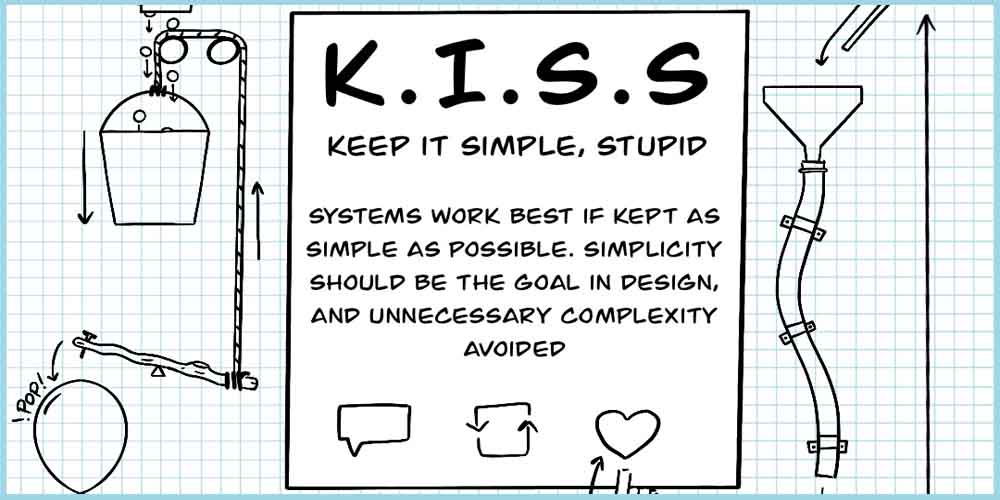UX writing is a critical aspect of web, app, and product design. It requires careful consideration to ensure the content meets specific conditions and characteristics for optimal performance. To achieve this, UX writers and designers should adhere to certain guiding principles. In the following sections, we outline the key UX writing principles that your next UX copy should follow to improve your product’s functionality.
What Is UX Writing?

When it comes to marketing physical and digital products, there are two types of practices: copywriting and UX writing. The first is committed to enticing leads or potential customers, while the second seeks to help current users navigate through apps or a particular product.
So, UX writing is the practice—and the art—of creating proper, concise, and useful copy to help users utilize the product. The main goal is to facilitate users’ access and comprehension of the product and prevent them from leaving it.
Now you know what UX writing is, let’s explain the main UX writing best practices and some examples of UX writing.
Principles that Every UX Writer Should Implement When Writing

Source: Limeup.
Let’s discuss some UX writing principles you should consider when writing your next UX content and developing your UX writing tools.
- It Should be Clear
Keep in mind that the UX copy will appear in every section of the application or product. In other words, it will be present in all the user interfaces that users will utilize, both within and outside the app. In this sense, the data you provide in the different sections and stages of the app should be clear and not leave room for misinterpretation or confusion.
The best way to promote clarity and ensure users understand your message is to use an active voice with clear verbs that truly reflect the brand voice. Avoid the passive voice, as it can distract users and not be clear enough.
- It Should be Accessible

Source: Leadpages.
Your app or product will be used by different people. Understanding this from the very beginning will help you address the UX copy from the users’ point of view and their needs.
Understanding what users need and why they go to the UX copy is the key to writing compelling UX content, facilitating the user journey, and lowering the cognitive load. For example, maybe some users of your app don’t understand the app’s terminology or how to get to a particular section.
In other words, your writing must enable all users, including those with disabilities, to fully access and use the app. The interaction between users and the product is the essence of the product itself, so it’s crucial to ensure ease of use for everyone!
- It Should be Straightforward
Remember: UX writing is not literature or a long description of facts or characteristics. It means you should avoid confusing language, technical jargon, complicated words, or any way of expression that can divert attention or the user from their main goal.
Your app, website, or product will naturally consist of various interconnected sections and parts. Therefore, the language and expressions used by the UX writer must clearly guide users toward actions they can take without causing confusion.
Consider that most users are not professional writers, developers, or technicians. They prefer not to overthink when navigating software or apps. Therefore, your UX copy should avoid complex language and be free of jargon.
- It Should Integrate Actionable Language

Source: Userguiding.
What makes UX writing good? Simplicity! Users seek simple explanations – diagrams, visuals, sentences, words, phrases, etc.– of what they need to know and do to solve problems, advance in new features, or even acquire a new product or service. In this sense, the UX copy you implement will support users and give them tools to continue advancing through the user journey.
Actionable language invites users to take action, such as clicking on links, reading tutorials, watching videos, contacting customer support, etc. It makes users feel they are advancing their knowledge of the app. You should use actionable language when creating a message for a sign-in error, security notes, loading issues, a landing page, or any UI text in the digital product.
- It Should Be Positive
Navigating an app, tool, or any product should be a pleasurable experience for users, not a frustrating one. Your UX copy should evoke positive feelings, encouraging users to continue exploring and discovering more about the product.
The best way to do this is to use positive affirmations and sentences that clearly benefit the user. Here are some examples of positive language:
- “Read this tutorial to learn how to…”
- “Head to the X section to see more of…”
- “On the next page, you will find…”
A good copy should avoid negative expressions that do not add anything to the experience. This way, you will communicate the “message” more positively, regardless of the reader. Some examples you should avoid when you seek to write positively are the following:
- “The app can’t..”
- “We don’t have that kind of information.”
- “Unfortunately…”
- “It’s a bad idea to know get this…”
- It Should Be Consistent

Source: Fastercapital.
Every document you create during your UX writing process—and even in other writing stages—should be consistent since it helps communicate the entire idea behind the copy.
But what do I mean by “consistency”?
The entire copy should have the same structure, intention, words, and language and clearly indicate what the user should do. The reader must feel that everything in the application, product, or document that the product designer has prepared has profound coherence.
You achieve this by presenting essential information with the right words and accuracy. Suppose the designers decide to use an interactive design to communicate the UX copy. In that case, you and the design team should also ensure that the interaction with the application is similar at every stage of the user experience.
One of the best ways to improve UX writing is to conduct user research. This will help you determine what the average user expects from the user experience and what words and intonation to use. It will also help you create the copy.
- It Should Be in Resonance with Visuals
Most writers may believe that the UX copy is totally independent of the visuals or designs that developers and designers integrate into the user interface and journey. For example, menu items contain words and phrases that must be aligned with visuals and icons. Whether during error messages or the acquisition of a product, the data you share should be enhanced and optimized by the visuals and images during the interaction.
This is why a good UX writer is also a UX designer: they must understand both visual and written languages. UX writers should attend all the meetings to stay informed about the designers’ work and ensure cohesive integration between design and content.
Moreover, visuals usually help customers since images, icons, indications, and others can greatly enhance the user experience of a digital product. In other words, visuals are an integral part of the message and experience on the screen.
- It Should Be Contextually Relevant

Source: Justinmind.
You will likely release your application in several locations. In this context, you should modify and even translate the UX copy according to the location and cultural background. Moreover, suppose your app focuses on a specific region or country. In that case, you should use words and expressions of that context to facilitate understanding and inform users about any aspect of your app. Of course, avoid jargon in the context and be clear, concise, and straightforward regardless of the region.
UX localization is a must for any good user experience since customers want to know they are treated with a “near” business or will be heard by a local representative when they have questions or issues. Besides, information about local solutions and even a physical location where users can go are also good ideas that bring value to the brand. Remember, the more detail about the contextual region, the more clarity for users about the location and what hope of the product.
- It Should Be As Simple As Possible

Source: Sketchingdev.
Smart writing is a hallmark of great UX writing, characterized by clear and simple communication of concepts and ideas. In general, effective writing—whether in copywriting, content writing, or literature—is simple and direct, and this is especially true for UX writing. You might have heard the expression “KISS” or “Keep It Simple, Stupid.” While the phrasing may be blunt, the principle remains important: simplicity is key.
Good UX writing is defined by its clear intention to convey messages and instructions with simple words, always prioritizing user understanding. UX writers and content strategists should always remember that all the copy they create will guide users through various stages and phases of their journey. You certainly don’t want the customer to get lost along the way, do you?
Simplicity goes hand in hand with consistency and straightforwardness when writing copy. Every sentence should be short and direct. You can even use a single word to emphasize a feature or characteristic. Do not forget that your tone of voice also makes an important difference according to the message you want to convey. Write short and avoid shenanigans and confusion!
- It Should Be Written by Professional UX Writers

It is a sad truth that many people believe that professional writing is not much different from writing essays at school or university. Nothing could be further from the truth! In reality, commercial writing for websites, apps, and other forms of digital products demands a blend of technique, knowledge, communication skills, talent, and artistic vision.
When crafting UX copy, you should ensure users grasp your message clearly and want to follow it. That’s why, if you’re a brand or business looking to develop an app or website with exceptional UX copy, you should consider hiring top-notch UX writers to devise a stellar content strategy and provide you with all the services you expect.
For this task, look no further than the creative minds and UX writing prowess found within the GamerSEO team! As a leading marketing agency, GamerSEO boasts a comprehensive team of creators, designers, and writers dedicated to crafting the UX copy for your website, web apps, products, and brand.
Send us a message through our contact form to check and build the next steps in your UX design process! Trust in our unbeatable team members, and let’s take your brand together to the next level!
- It Should Be a Collaborative Effort

Source: Uxcam.
It’s fundamental that your UX writers work closely with other professionals. Of course, writers boast other abilities and contribute directly to other parts of the UX copy – such as the visuals and design – but collaboration is crucial. Some crucial professionals are the following:
- UX designers are the professionals who design the graphic sections of interfaces and what the user sees during the user journey.
- Internal stakeholders. Both internal and external stakeholders are likely to participate continuously in the brand’s processes. Consider their opinions about interfaces, processes, and the UX experience.
- Developers. These professionals are in charge of developing interfaces, menus, functions, and other aspects that make the navigation system functional.
- Product Managers make all the decisions about what to do and what not to do. They use the customer’s perspective to understand what clients want and boost campaigns in that direction.
- Researchers. Even though the UX writer should carry out their research, sometimes the brand can hire researchers who investigate users’ cultural backgrounds and relevant characteristics more deeply.
- Optimization managers. These professionals are the product team members who will help the UX writer use words effectively in harmony with visuals, interfaces, and other product components.
- Testers. User testing will provide you with insights into what aspects of the UX experience you should modify and improve. Testers can make you note issues with the UX writing process.
- It Should Be Useful and Effective
Focus your efforts on usefulness and effectiveness. This principle may be the most obvious, but many UX writers overlook it. The UX content helps users navigate through the digital product. Whether displaying an error message or confirmation message, communicating the acquisition of a product, or sharing crucial information, the UX copy must inform and guide the user effectively.
Good, useful, and effective UX writing entails knowing the reasons and preferences of your current and future users. Understanding why your users use your app or product and what they care about can make your copy highly usable. The best way to do this is by conducting surveys, user tests and interviews, and usability studies.
Head your user base and ask users for their experience and preferences. With the data you will receive, you can create content strategies to provide accurate and useful information to users. Explanations and examples should also have as many details as you consider essential to create a good microcopy.
The Bottom Line
Clear and good UX writing copy provides a comfortable, easy, effective, and helpful experience that makes the user feel accompanied, considered, and guided through the user journey. Not everything is just about purchasing or downloading a particular product. The user experience once the customer already consumed the product is also relevant.
We hope this UX writing style guide has been of interest to you, writer! Since we know you play a critical role in your product, we’re giving you all the steps and tools you need to be the best in your industry!
For other related and interesting topics, read the articles on our blog!

Visual artist, professional writer, and senior content creator specializing in digital marketing and copies that resonate with readers and users. For more than eight years, he has provided significant contributions to companies interested in positioning their brands and products by creating marketing strategies and high-quality content based on SEO. His writing ranges from construction and architecture to gaming and cryptocurrencies, including sales, investments, travel, and more. Currently, he participates in several Spanish and English companies, proposing, planning, and delivering unique copies. Football player twice a week, a published author, and a fan of the Final Fantasy series.

